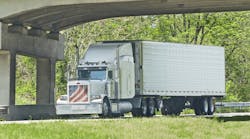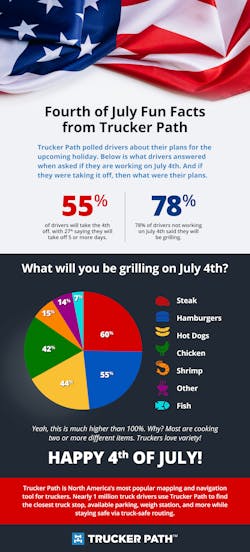The roads will be crowded as millions of Americans are expected to travel over the long Independence Day holiday weekend. With the Fourth of July falling on a Tuesday, many could take advantage of extra time for road trips and local travel to celebrations during the United State's 247th birthday.
American Trucking Associations' Share the Road drivers encourage motorists to be safe on the nation's highways and offer several tips to help travelers arrive at their destinations this summer. Motor Club AAA expects a record-breaking 50.7 million Americans to travel more than 50 miles this holiday weekend.
"Given the unprecedented number of individuals hitting the road to connect with loved ones this holiday weekend, it is imperative to prioritize and promote safe driving practices," said Richard Frazer, an ATA Share the Road professional truck driver who works for LTL carrier Yellow (No. 6 on the FleetOwner 500: Top For-Hire Fleets of 2023). "We all deserve a relaxing and celebratory holiday, and by implementing these safety tips, the general motoring public can ensure a safe journey for themselves and their fellow travelers."
See also: Can you pass this trucking speed quiz?
Frazer, and the rest of the Share the Road team, are using the July Fourth holiday to urge Americans to remain focused and alert while behind the wheel. The team offered several other common sense safety tips so everyone on the roads, including professional truck drivers delivering hot dogs, ice cream, and sparklers, can arrive safely and efficiently.
"By following simple guidelines such as buckling your safety belt, reducing your speed, and ensuring your vehicle is ready for long-distance travel, you can significantly contribute to safer driving on the highways," said Gina Jones, another Share the Road professional truck driver with Werner Enterprises (No. 13 on the FleetOwner 500). "We want people across America to savor a relaxing and enjoyable time with family and friends this holiday weekend, and by incorporating our tips, you can vastly enhance highway safety."
Driving tips for sharing the road with tractor-trailers
The Share the Road professional drivers extend the following top 10 safety tips, particularly relevant when operating small passenger vehicles near large tractor-trailers:
- Buckle up: Independence Day witnesses heightened congestion on highways, and wearing your safety belt is a life-saving practice. Remember always to buckle up.
- Slow down: Driving faster than surrounding traffic triples the chances of a collision. Spring and summer mark the busiest periods for work zones in the country, so reducing speeds while traveling through those areas during the holiday is vital.
- Do not drive impaired: While Independence Day offers an occasion to celebrate our freedoms, impaired driving is not one of them. It endangers not only yourself but also the freedoms of others. Prioritize safety by planning your holiday activities responsibly. It's always better to play it safe.
- Be mindful of truck blind spots: When sharing the road with large trucks, be mindful of their blind spots. If you cannot see the truck driver in their mirrors, they cannot see you.
- Keep your eyes on the road: Distracted driving remains a significant cause of traffic accidents. Just two seconds of distraction doubles the chances of an accident. Use your cell phone only when parked, and never text while driving.
- Do not cut in front of large trucks: Remember that trucks are heavier, and a fully loaded truck traveling at highway speeds requires the length of two football fields to come to a complete stop. Avoid cutting quickly in front of them.
- Prepare your vehicle for long-distance travel: Before leaving home, ensure your wipers, fluids, and tire pressure are in good condition. Have your radiator and cooling system serviced. Simple maintenance before you leave your home can prevent many of the problems.
- Leave early and avoid risks: Leave early so you will not be anxious about arriving late. Many major cities can expect delays, and road conditions may change due to inclement weather or traffic congestion.
- Be aware of the vehicle in front of you: Leave extra room between you and the vehicle ahead in case of sudden stops.
- Be safe in and around neighborhoods: Watch for children in neighborhoods who could be playing on or near residential streets. We want everyone to be able to enjoy the fireworks safely.




